Overview
This article delves into the multifaceted applications of multi-electrode arrays (MEAs) within neuroscience research. By highlighting their critical roles in:
- Drug testing
- Disease modeling
- Synaptic plasticity studies
- Neurotrauma research
- Cardiac research
- Real-time monitoring of neuronal activity
it becomes evident that MEAs are indispensable tools in the scientific community. These applications not only underscore the significance of MEAs but also enhance our understanding of neural networks and their intricate interactions. MEAs facilitate precise and simultaneous measurements of electrical activity from multiple neurons, thereby driving advancements in both fundamental and applied neuroscience research. In summary, the utilization of MEAs represents a pivotal advancement in the quest to unravel the complexities of neural dynamics.
Introduction
In the realm of neuroscience, the quest to unravel the intricate workings of the brain has made significant strides with the introduction of multi-electrode arrays (MEAs). These advanced tools are transforming research by enabling scientists to monitor the electrical activity of multiple neurons simultaneously, yielding unparalleled insights into neuronal behavior and interactions. As the demand for precision in neuroscience increases, the role of MEAs becomes increasingly vital across various applications, including:
- Drug testing
- Disease modeling
- Synaptic plasticity studies
- Neurotrauma research
With projections indicating rapid market expansion for these sophisticated technologies, the influence of MEAs on neuroscience research is set to reshape our understanding of neurological conditions and propel innovations in therapeutic strategies.
JM Science Multi-Electrode Arrays: Precision Tools for Neuroscience Research
JM Science presents an advanced selection of multi electrode array configurations that are meticulously designed for precision in neuroscience studies. These innovative multi electrode arrays enable the simultaneous measurement of electrical activity from multiple nerve cells, yielding critical insights into cellular behavior and interactions. The robust design of JM Science's devices guarantees dependability and precision—essential elements for producing consistent findings. With , these devices are tailored to meet the rigorous demands of contemporary neuroscience research.
The significance of accuracy in neuroscience is paramount; as leading neuroscientists assert, precise measurements are vital for comprehending complex neural networks. Recent statistics reveal a burgeoning market for medical equipment assemblies, with projections indicating substantial growth fueled by increased investments in healthcare infrastructure and medical studies. By 2033, the medical equipment assemblies market is expected to expand significantly, underscoring the rising necessity for sophisticated tools that enable thorough neuronal analysis. JM Science's unwavering commitment to innovation is evident in its multi electrode array products, which incorporate the latest technological advancements to enhance study capabilities.
For example, the Asia Pacific region has witnessed considerable market activity, with companies like MaxWell Biosystems AG actively promoting their multi electrode array systems, reflecting the dynamic nature of this field. By offering high-performance membrane electrode assemblies, JM Science positions itself as a pivotal contributor in the evolving realm of neuroscience exploration, supporting scientists in their quest for deeper insights and advancements in the discipline. Furthermore, as highlighted by the Alzheimer's Association, the prevalence of Alzheimer's disease is projected to rise significantly, emphasizing the critical need for effective research instruments to investigate neurological disorders.
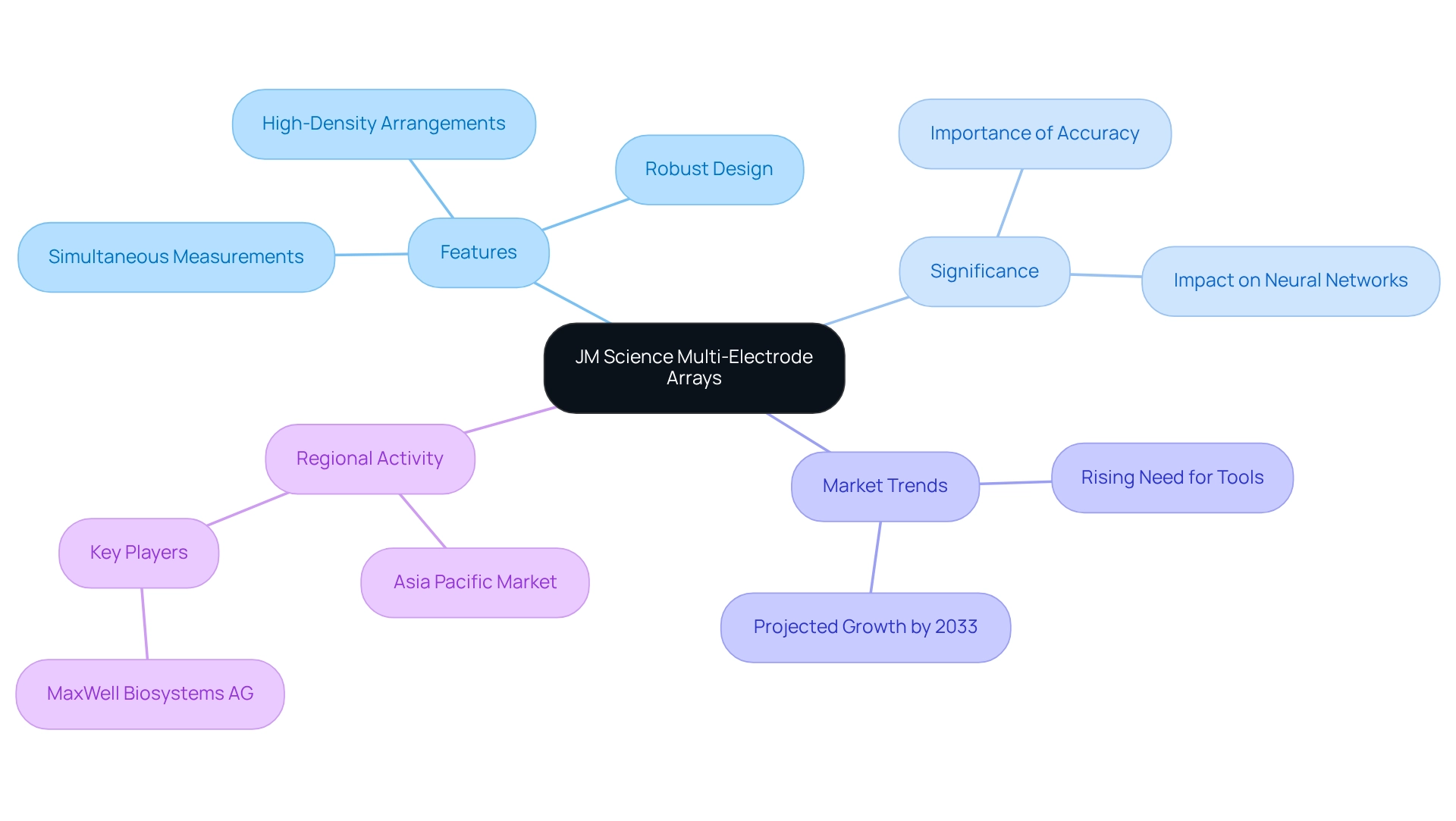
Drug Testing: Utilizing Multi-Electrode Arrays for Effective Pharmacological Studies
Multi electrode array systems are revolutionizing pharmacological research by providing an advanced platform for assessing drug impacts on nerve cell activity. These systems empower researchers to monitor the electrical responses of neuronal networks to various compounds, facilitating the identification of potential therapeutic agents and evaluating their safety profiles. The ability to conduct high-throughput screening with a multi electrode array significantly accelerates the drug discovery process, yielding comprehensive insights into drug mechanisms of action.
Recent studies underscore the effectiveness of the multi electrode array in drug testing, with data indicating that the internal standard TSP consistently appeared in samples at a concentration of 0.58 mM. This precision in measurements is vital, as it ensures the reliability of data obtained during drug testing, ultimately influencing the accuracy of toxicity assessments and therapeutic evaluations. Furthermore, anticipated outcomes for muscimol and fluoxetine combinations suggested that actual toxicity levels were lower than previously estimated, demonstrating the nuanced understanding provided by assays such as the multi electrode array in toxicity evaluations and emphasizing the importance of precise data in drug safety assessments.
Expert insights highlight the role of these assays in enhancing drug discovery timelines. Researchers have noted that the reproducibility of electrophysiological parameters, as evidenced by comparisons of neuronal progenitor cells (NPCs) and astrocytes across various MEA plates, confirms the robustness of differentiation protocols. This consistency is critical for reliable pharmacological assessments, as it facilitates the comparison of results across different experiments and bolsters confidence in the findings.
By 2025, the use of microelectrode arrays in pharmacological investigations is expanding, with case analyses illustrating their impact on drug testing methodologies. For instance, recent pharmacological research has utilized microelectrode arrays to explore the neuroexcitotoxic effects of kainic acid, a glutamate agonist recognized as a gold standard for studying neurodegenerative diseases (Moloney, 2002). The integration of microelectrode arrays has been pivotal in pharmacological studies, allowing for an in-depth examination of drug interactions and their effects on neuronal networks. As the field progresses, the incorporation of into drug testing protocols is expected to yield even greater advancements in understanding drug efficacy and safety.
Disease Modeling: Multi-Electrode Arrays in Patient-Specific Neuron Research
are pivotal in disease modeling, particularly when utilizing patient-specific induced pluripotent stem cells (iPSCs) to generate neurons. This innovative methodology empowers researchers to explore the electrophysiological characteristics of neurons influenced by specific conditions, including Alzheimer's and Parkinson's diseases. By capturing the unique electrical signatures of these neurons, microelectrode arrays offer profound insights into disease mechanisms and facilitate the identification of potential therapeutic targets, thereby amplifying the translational potential of research findings.
Current trends highlight the synergy between microelectrode arrays and iPSC technology, which has demonstrated efficacy in the study of neurodegenerative diseases. A recent research initiative exemplified this, employing 384 replicate arrays across four culture preparations, showcasing the robustness of this approach. Researchers have recognized that the MEA technique is exceptionally effective in analyzing neurodegenerative diseases, providing critical insights necessary for the development of effective treatments. As Steven Schulte stated, "MEA technique has some key features reviewed here that make it a powerful tool in the analysis of neurodegenerative diseases."
Case studies further underscore the utility of MEAs in this domain. A notable instance is the application of MEA systems in safety pharmacology, where they can detect a broad spectrum of neurotoxic effects, including excitotoxicity and synaptic dysfunction. By utilizing human iPSC-derived neurons, this non-invasive platform enhances the assessment of compound safety, ultimately bolstering the drug discovery process.
Moreover, standardizing MEA parameters is critical for ensuring reproducibility in research involving astrocyte-neuron networks. Consistent reporting of methods can yield more reliable data, which is vital for understanding the roles of astrocytes in nerve networks and their implications in neurodevelopmental disorders. Additionally, the necessity of employing same-species and same-genotype cells for studying network phenotypes is paramount, as it is essential for achieving accurate and meaningful results. This emphasis on standardization is crucial as the field evolves, striving for enhanced accuracy in disease modeling with patient-specific neurons.

Synaptic Plasticity Studies: Insights from Multi-Electrode Array Technology
Multi-electrode systems are pivotal in the exploration of synaptic plasticity, enabling researchers to monitor changes in nerve connectivity and activity patterns over time. By delivering precise electrical stimulation and recording the subsequent brain responses, scientists can delve into the development of synaptic strength during learning processes. This capability is vital for deciphering the mechanisms underlying memory formation and retrieval, providing profound insights into cognitive functions.
Notably, research utilizing a multi electrode array has demonstrated significant alterations in nerve connectivity, showcasing how networks adapt to stimuli. The variability in the number of cultures used to compute averages across different cell densities underscores the reliability of data derived from MEAs. Furthermore, the application of statistical methods, such as the False Discovery Rate (FDR), has enhanced the analysis of large datasets, facilitating the identification of critical stimulus-response relationships within cultured nerve cell networks.
This is particularly evident in the case study titled 'Quantitative Analysis of Network Activity,' which addresses the challenges in comprehending hybrid neural-electrical circuits and highlights the necessity for advanced statistical tools to analyze extensive spike-based datasets. Additionally, Bourne & Harris observed that mushroom spines possess (PSDs), anchoring more AMPA glutamate receptors, thereby strengthening these synapses functionally.
These findings underscore the importance of the multi electrode array in enriching our understanding of synaptic plasticity and memory, as it provides a dynamic perspective on how learning processes manifest in brain activity. This study received support from an EC FP6 funding grant and a Hong Kong UGC CERG grant, further validating the significance of these investigations.
Neurotrauma Research: Investigating Traumatic Brain Injury with Multi-Electrode Arrays
In neurotrauma research, are pivotal for investigating the effects of traumatic brain injuries (TBIs) on nerve networks. By capturing electrical activity from neurons in TBI models, researchers can assess how injuries disrupt nerve cell function and connectivity. This assessment is crucial for elucidating the pathophysiology of TBIs and for developing targeted therapeutic interventions that facilitate recovery and rehabilitation.
Recent studies indicate that 27.34% of electrodes with considerable correlation were positioned within high-activity regions at baseline across all subjects, underscoring the efficacy of multi electrode arrays in identifying critical areas affected by trauma. Moreover, statistical analyses have confirmed significant differences in brain responses post-TBI, offering insights into the alterations in neural networks.
For example, the application of multi electrode arrays in experiments at Imperial College London demonstrated the reproducibility of shock waves and their impact on neuronal function, showcasing the potential of high-density EEG as a diagnostic tool for TBI. The data will be made available upon reasonable request to the corresponding authors, emphasizing the collaborative nature of research in this domain.
Additionally, the crucial finding that ERASE was more effective at preserving EEG features associated with movement than traditional ICA highlights advancements in EEG analysis relevant to TBI studies. These discoveries underscore the importance of multi electrode arrays in deepening our understanding of TBI pathophysiology and the intricate interactions of neuronal networks following injury, even amidst the logistical challenges posed by COVID-19.
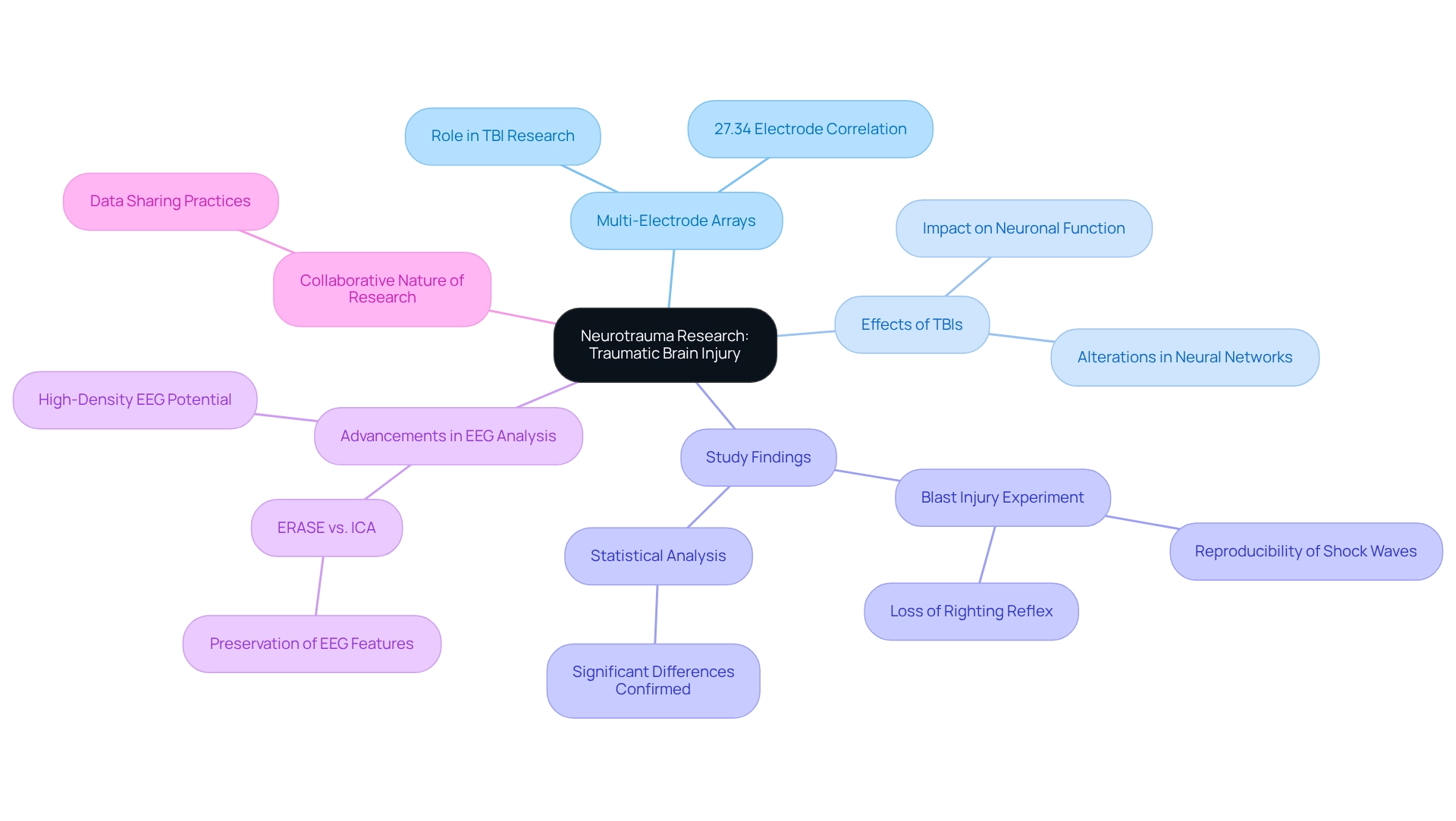
Cardiac Research: Exploring Heart Function with Multi-Electrode Arrays
Multi electrode arrays play a pivotal role in cardiac research, particularly in the investigation of cardiomyocyte electrical activity. By capturing the electrical signals emitted by heart cells, researchers can explore the mechanisms underlying arrhythmias, assess the effects of pharmacological agents, and evaluate the overall health of cardiac tissues. This technology not only deepens our understanding of heart function but also facilitates the development of innovative treatments for cardiovascular conditions.
Recent advancements in MEA technology have led to the introduction of , which are particularly effective for in vivo arrhythmia detection and monitoring. These systems enable on-demand site-specific pacing, essential for investigating and addressing cardiac dysfunctions, thereby providing critical insights into the heart's electrical activity. A significant case analysis has confirmed the long-term stability and performance of bioresorbable materials, validating their suitability for temporary applications in physiological environments. Over the course of several days, these multi electrode arrays demonstrated stable functionality while gradually undergoing bioresorption, highlighting their potential in cardiac research.
The rising demand for multi electrode arrays in cardiac applications is evident in the increasing number of new product launches within the market, propelled by technological innovations. By 2025, the integration of multi electrode arrays in cardiac studies has gained momentum, with research highlighting their effectiveness in monitoring the electrical activity of cardiomyocytes. Cardiologists have recognized that employing MEA technology offers a straightforward approach for screening compound-induced effects on cardiac electrophysiology, further emphasizing the significance of these tools in enhancing our understanding of heart health. This is particularly relevant when utilizing human induced pluripotent stem cell-derived cardiomyocytes (hiPSC-CMs), which serve as a valuable model for cardiac studies.
In conclusion, the application of multi electrode arrays in cardiac investigations not only enriches our comprehension of arrhythmias but also lays the groundwork for groundbreaking treatments. For pharmaceutical lab managers, leveraging MEA technology can substantially improve study outcomes and contribute to the ongoing mission of advancing cardiovascular health.

Neuronal Cultures: Advancing Research with Multi-Electrode Array Technology
Multi-electrode systems, utilizing a multi electrode array, are revolutionizing the examination of nerve cell cultures by facilitating simultaneous recordings from numerous neurons, a critical component in understanding the intricate dynamics of neural networks and their responses to various stimuli. This technology provides immediate insights into brain cell activity, empowering researchers to delve into vital inquiries regarding cell communication and network dynamics.
Recent studies have highlighted the effectiveness of multi electrode array technology in drug testing, particularly through investigations conducted at the Stem Cell Research and Technology Resource Center at the University of Colorado Boulder. This research revealed significant alterations in network activity in response to pharmacological agents, affirming the utility of nerve cell cultures in assessing potential neuroprotective treatments. Notably, Gramowski et al. (2004) identified 30 distinct statistical features to characterize network activity across six different pharmacological conditions, illustrating the analytical prowess of multi electrode array technology in deciphering brain responses.
Moreover, advancements in multi electrode array technology have enhanced integration with existing software, particularly through the introduction of additional tools for seamless spike sorting. This improvement substantially aids the academic community's capability to analyze complex data. Expert insights, such as those from Mossink et al. (2021), underscore that electrodes positioned near dense clusters of nerve cells frequently detect firing rates considerably higher than those in other areas, emphasizing the significance of spatial factors in network analysis.
The use of multi electrode arrays to collect real-time data from nerve cell networks not only fosters a deeper understanding of nerve cell dynamics but also enables scientists to leverage these insights in practical pharmacological studies and therapeutic development. For instance, precise monitoring of nerve responses can facilitate more targeted drug testing and the identification of neuroprotective agents. As the field continues to advance, the integration of multi electrode arrays into will undoubtedly play a crucial role in advancing neuroscience research.
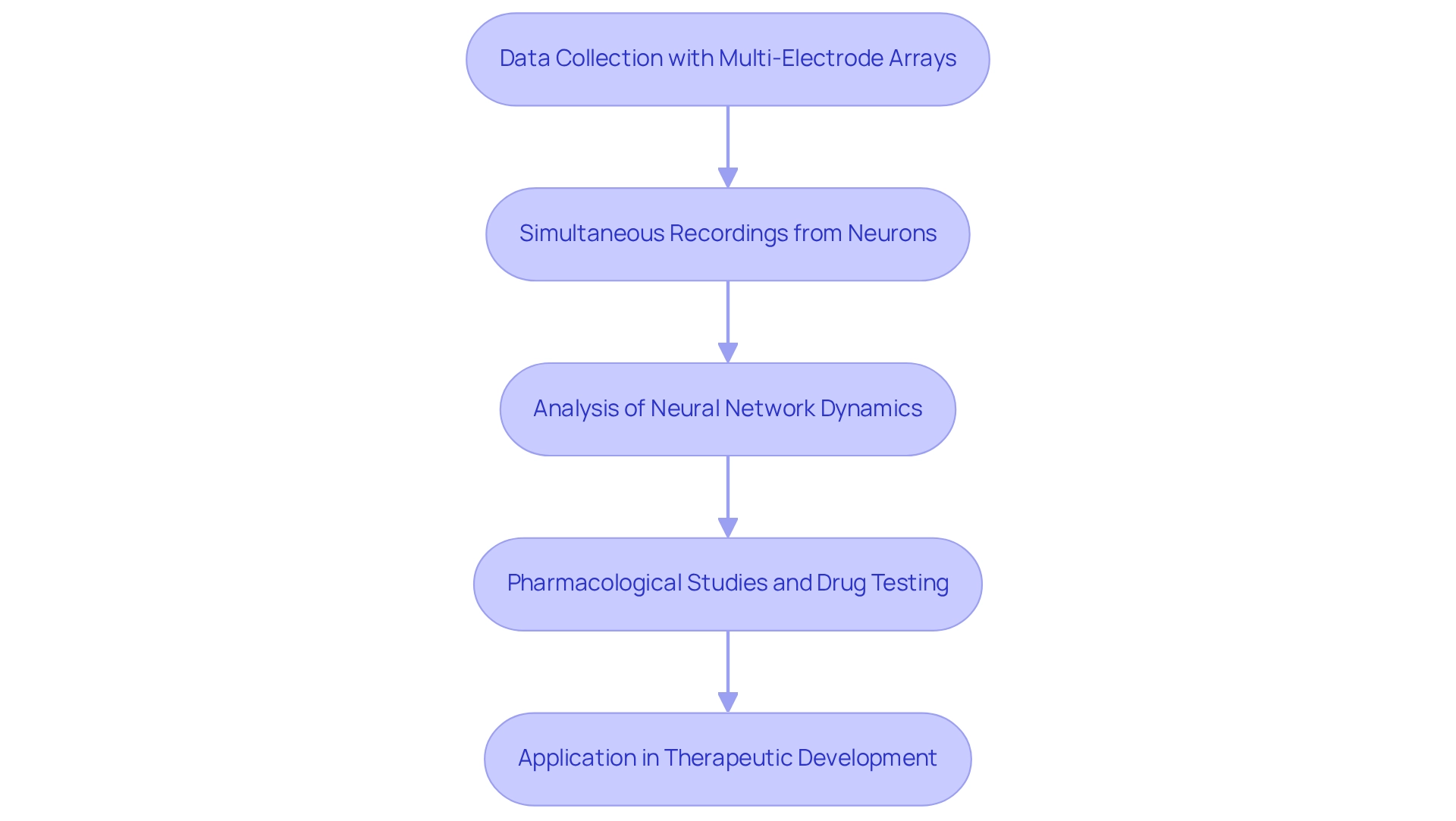
High-Density Microelectrode Systems: Enhancing Data Collection with Multi-Electrode Arrays
High-density microelectrode systems signify a transformative leap in multi electrode array technology, allowing for the recording of electrical activity from a considerably greater number of neurons with improved spatial resolution. This capability allows researchers to collect intricate data on nerve interactions and network dynamics, facilitating a deeper understanding of brain function and the underlying mechanisms of various diseases. The ability to analyze complex neuronal networks with high precision is essential for advancing neurobiology, particularly in addressing challenges such as mapping neuronal connectivity. Recent research demonstrates that networks can contain 14 to 52 neurons per culture, highlighting the potential of these systems to provide extensive datasets that enhance our comprehension of neural processes.
Moreover, the microelectrode array market is categorized into Classical MEA, Multiwell-MEA, and CMOS-MEA, each offering distinct applications that can improve experimental capabilities. Insights from case studies, such as those addressing the challenges in mapping neuronal connectivity, underscore the necessity of innovative approaches in this area. Furthermore, advancements in methods for visualizing relations between temporally adjacent events in high-resolution maps further emphasize the progress in data collection techniques associated with multi electrode arrays. As neuroscientists increasingly recognize the advantages of high spatial resolution in multi electrode arrays, the influence of high-density microelectrode systems on data gathering continues to expand, paving the way for innovative methodologies and breakthroughs in the field. The urgency of these advancements is underscored by the , projected to rise from 8.5 million in 2030 to 13.8 million in 2060 among the population aged above 85, highlighting the critical need for continued research in neuroscience.

Real-Time Monitoring: Capturing Neuronal Activity with Multi-Electrode Arrays
Multi-electrode systems facilitate real-time observation of brain cell activity, allowing researchers to monitor brain cell responses to various stimuli as they occur. This capability is essential for investigating synaptic transmission, network dynamics, and the effects of pharmacological agents. By capturing temporal information, researchers can delve into the dynamics of nerve interactions, a critical aspect of understanding brain function and its modulation, with investigations utilizing multi electrode arrays highlighting the importance of temporal data in elucidating synaptic transmission mechanisms. Researchers have noted that the ability to observe nerve cell activity in real-time fosters a more nuanced understanding of how synaptic connections evolve under different conditions. This insight is particularly pertinent in the context of disorders linked to synaptic dysfunction, where real-time observations can inform therapeutic strategies.
Furthermore, the advent of automated analysis tools, such as the autoMEA software, has significantly improved the reliability of data interpretation in MEA studies. This software provides a high-throughput approach for analyzing complex neural activity, thereby minimizing inter-experimenter bias and enhancing data consistency. Additionally, newer software tools like SpikeForest and SpikeInterface serve as valuable starting points for researchers exploring spike sorting methods, streamlining the comparison and evaluation of various automated algorithms. Statistics indicate that multi electrode arrays can simultaneously track multiple aspects of neuronal activity, including spiking activity, network synchronicity, rhythmicity, and burst characteristics, offering a comprehensive view of network behavior. This capability is crucial for generating reproducible data, especially in studies examining astrocyte-neuron interactions, where standardizing MEA parameters is vital. Moreover, clearly outlining statistical methods, including whether adjustments for multiple comparisons were made, is essential for ensuring transparency in data presentation and enhancing the reliability of results.
Expert insights emphasize the transformative potential of multi-environmental assessments in neuroscience research. Researchers assert that integrating real-time monitoring capabilities with can lead to breakthroughs in understanding nerve dynamics and their implications for health and disease. As the field continues to evolve, the role of multi electrode array technology in capturing the temporal aspects of neuronal activity will remain pivotal in advancing our comprehension of the brain. Additionally, innovations such as the use of biocompatible epoxy resin for sealing MEA chips contribute to long-term stability in experiments, further bolstering the reliability of findings.
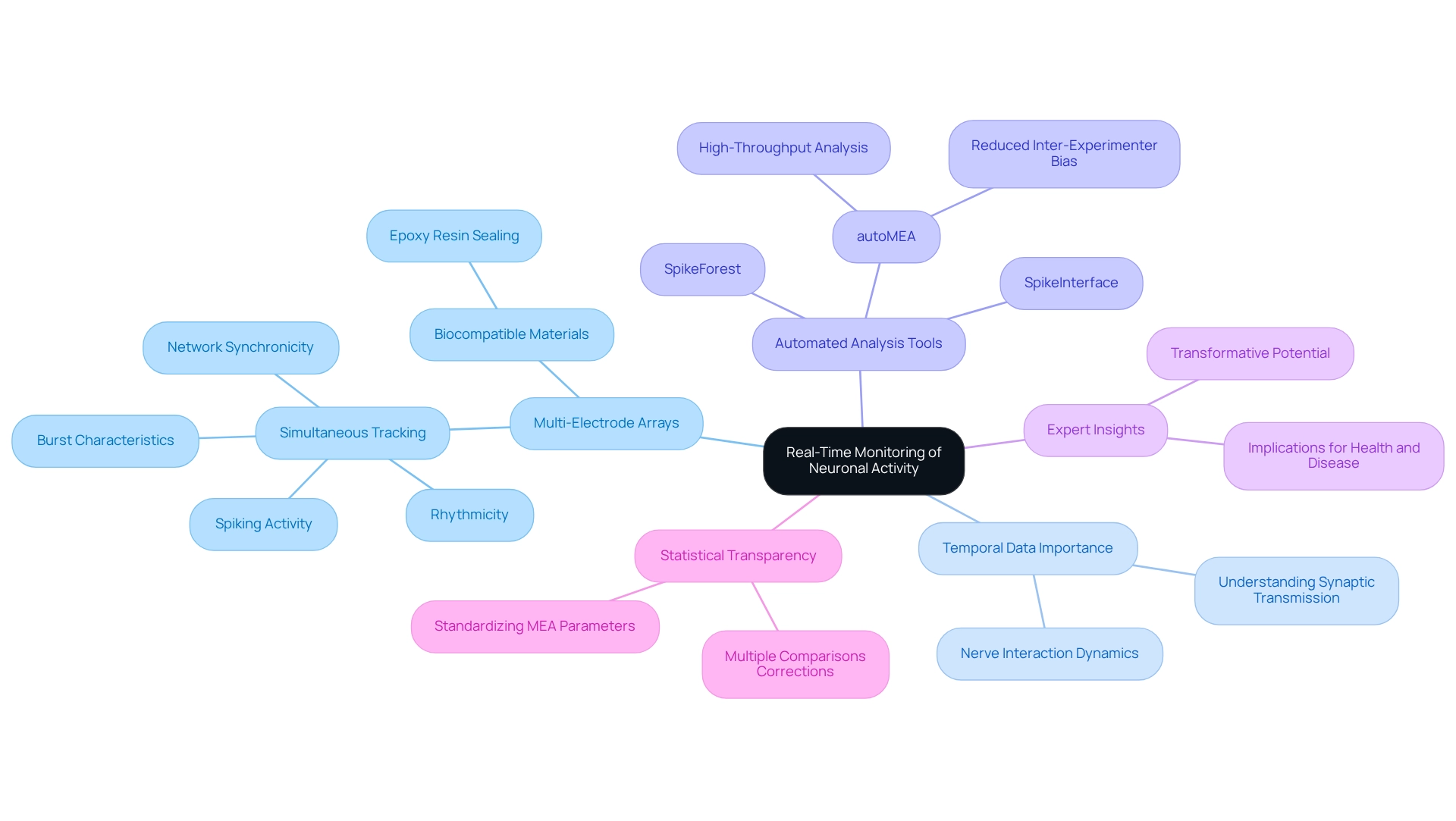
Future Innovations: The Evolving Role of Multi-Electrode Arrays in Neuroscience
The future of multi electrode array technology in neuroscience research is exceptionally promising, driven by continuous innovations that enhance their functionality and application. Emerging technologies, particularly flexible and 3D multi electrode arrays, are being developed to facilitate better integration with biological tissues. This advancement allows for more precise and comprehensive studies of neuronal activity, which is crucial for understanding complex brain functions.
is experiencing significant growth, with a compound annual growth rate (CAGR) of 12.2% projected during the forecast period. This growth is mainly linked to the rising use of MEA technology among various academic institutions, especially in North America, where prominent educational centers are at the forefront of MEA innovation. Funding from government agencies and private investors further bolsters this research, solidifying the region's dominance in the global market. Notably, the market is semi-fragmented, with key players such as:
- 3Brain AG
- Multi-Channel Systems MCS GmbH
- Axion BioSystems
contributing to the competitive landscape. As the field evolves, multi electrode arrays are anticipated to play an increasingly essential role in enhancing our comprehension of the brain and formulating new therapeutic approaches for neurological disorders. Researchers are optimistic about the potential of flexible and 3D multi electrode arrays, which promise to revolutionize how neuronal interactions are studied. In a recent webinar series organized by the American Physiological Society, experts discussed the methodological considerations and best practices for cardiac research using MEA technology, highlighting its relevance in current research discussions. These innovations not only enhance the capabilities of MEAs but also open new avenues for exploring the complexities of neural networks, ultimately contributing to breakthroughs in neuroscience and related fields.
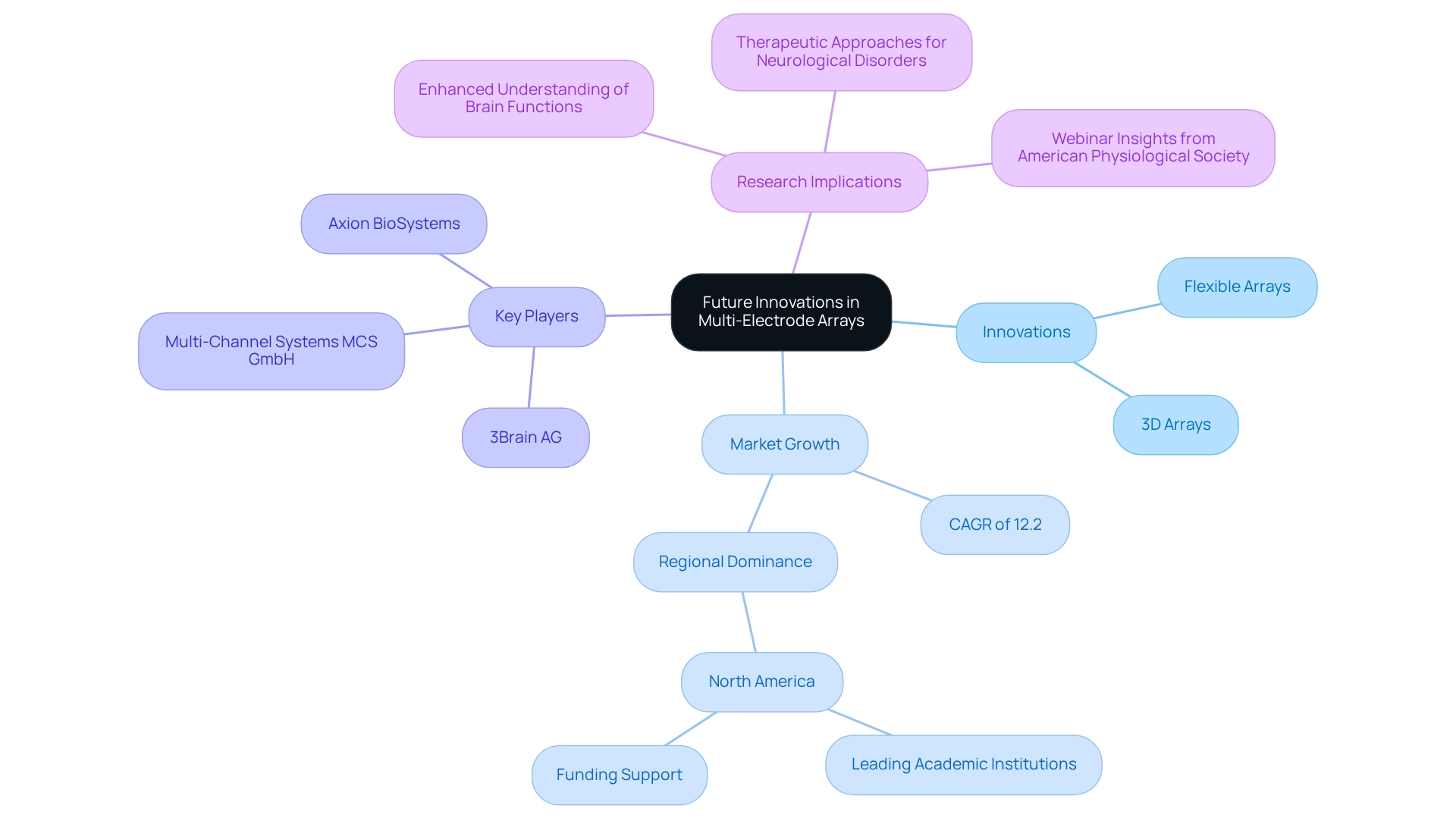
Conclusion
The integration of multi-electrode arrays (MEAs) into neuroscience research signifies a transformative era in our understanding of the brain's intricate workings. These sophisticated tools enable simultaneous monitoring of neuronal activity, allowing researchers to gain critical insights into drug testing, disease modeling, synaptic plasticity, and neurotrauma studies. The precision and reliability of MEAs are essential for generating reproducible data, which is vital for advancing therapeutic strategies and comprehending neurological conditions.
The expanding market for MEAs, propelled by technological advancements and increasing investments in healthcare, underscores their growing significance in neuroscience. With applications ranging from pharmacological studies to patient-specific neuron research, MEAs are set to enhance our understanding of complex neuronal networks and their implications in various diseases, including neurodegenerative disorders. Ongoing innovations in MEA technology, such as the development of flexible and 3D arrays, promise to refine these capabilities further, paving the way for groundbreaking discoveries.
In conclusion, the role of multi-electrode arrays in neuroscience is not merely a trend; it is a pivotal component in the quest for deeper insights into brain function and the development of effective therapies. As research continues to evolve, the impact of MEAs on our understanding of neuronal dynamics will undoubtedly lead to significant advancements in both basic and applied neuroscience, ultimately improving outcomes for individuals affected by neurological disorders.




